|

Biodiversity, Biomass and Carbon fixing:
Misconceived notions
by W.R.H. Perera
 Being a Botanist-Forester-Agriculturist of a bygone era may I venture
to portray some observations and and thoughts for laymen. Being a Botanist-Forester-Agriculturist of a bygone era may I venture
to portray some observations and and thoughts for laymen.
We as environmentalists proclaim-that water is the lifeblood of the
nation. Today global warming and all its ramifications, including
"hysterical climatic fluctuations could well be called the life
threatener" of the nation.
 Why are these comments being made? In my opinion, among the multitude
of laymen-even the well-educated-there maybe some misconception in
relation to trees (plants); resulting in a dangerous situation. These
observations are confined to the plant kingdom. What is Biodiversity? It
may be called an ecologically compatible mixture of different species -
or an amalgam of plants species in an area. In the case of multi-tiered
natural forests; evolved over a period of millions of years;
biodiversity is extremely high. Why are these comments being made? In my opinion, among the multitude
of laymen-even the well-educated-there maybe some misconception in
relation to trees (plants); resulting in a dangerous situation. These
observations are confined to the plant kingdom. What is Biodiversity? It
may be called an ecologically compatible mixture of different species -
or an amalgam of plants species in an area. In the case of multi-tiered
natural forests; evolved over a period of millions of years;
biodiversity is extremely high.
Biodiversity has been well covered by articles written by learned
scientists an environmentalists. They have enumerated the inestimable
benefits of biodiversity. One of these benefits is the positive
advantages against global warming-due to the part it plays in Carbon
fixing.
What is Biomass? When applied to trees and other vegetation - it is
the total living matter - root system - stem (trunk, branches and twigs)
and above all the foliage.
Biodiversity has very high biomass - but biomass is necessarily not
bio-diversity-It can be refereed to an individual tree or plant - or to
an aggregate of plants of a single species or a single species-as in
forestry and agricultural plantations.
What is Carbo-fixing? The ramified roots of a plant take in water and
nutrients. The foliage and other matters with chlorophyll-take in Carbon
dioxide from the atmosphere and release Oxygen during photosynthesis.
Oxygen is released to the atmosphere, while Carbon and nutrients
taken by the roots build up the massive anatomy of the plant - from the
tiny seedlings to the Giant Red-Woods of the Red-Wood (Sequla) Forests.
Carbon is fixed in the process and life giving Oxygen released to the
atmosphere. Could we say what the most important component of the
anatomy of a plant is it the root system or foliage?
It should also be mentioned that Carbon fixing is not a process
confined to photosynthesis and nutrient flow. Since during respiration
plants take in Oxygen and give out Carbon-dioxide and produces energy.
It should be realised that Biodiversity, biomass, and Carbon fixing,
though inter-related and having a great impact on the environment, are
different concepts.
These comments are made since there are many misconceived notion.
Recently top policy makers wanted, unwanted trees-specifically
mentioning Pinus-removed from the catchment areas of reservoirs, what a
folly?
There are no unwanted trees in relation to
biodiversity-biomass-Carbon fixing or general amelioration of the
environment.
Let me mention a catastrophic situation that was very narrowly
avoided, and a hysterical, irrational environmental action, aborted in
the nick of time.
The Uda-Walawe reservoir-a major irrigation project, was completed in
the early 1980's. A major part of the catchment area of Uda-Walawe, is
the mountainous areas between Haldummula and Belihul-Oya. Vast extents
of this catchment was a denuded abandoned lands-spreading up to the rim
of Horton Plains.
Many of these areas were the abandoned coffee plantations of the 19th
century.
Commencing in 1967, the Forest Department clothed thousands of acres
of this denuded catchment with Pinus and Eucalyptus plantations mostly
Pinus.
On completion, in spite of rain the reservoir was not filling up.
There was much public agitation and hysterical protest about pinus
plantations.
The project manager- a charming retired engineer, and closely
connected to the President J.R. Jayawardena, was a regular walker with
me, at Independence Square.
He was under severe pressure for not saving the reservoir.
One morning the blurted out to me "those dam Pinus plantations are
supposed to be sucking up all the water, they will have to be cleared"!
I was stunned!
Mercifully within a couple of weeks it was announced that experts had
discovered a massive leakage of water under the reservoir-maybe due to a
geological fault or a technical constructive fault, or both.
Engineering experts were rushed from abroad, who eventually "Plugged"
the leak, and the reservoir began to fill up-thereby saving the
thousands of acres of forest plantation and avoiding anenvironmental
catastrophe, due to irrational, hysterical conjecture. Maybe another
example of ironical behaviour should be given. I cannot vouch for the
authenticity of the photograph or sites.
About 30 years ago, the media carried the photograph of the patana
land-giving the name of the village in the Welimada area and the news
item that the area was to be planted with Eucalyptus. There were howls
of protest-including politicians-that Eucalyptus would dry up the
streams.
Sometime back-about two years ago-the media carried the photograph of
the same site, but this time carrying a eucalyptus plantation and a
tractor.
The protests now were that by permitting the contractor to fell
Eucalyptus the streams in the area would dry up!
(The writer is retired Conservator of Forests Former Chairman, State
Timber Corporation)
The Sooty Tern:
The newest breeding resident bird in Sri Lanka
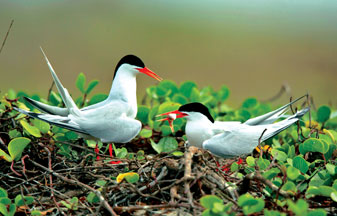 A study conducted from May to August this year, by the Ceylon Bird
Club (CBC) at the Adams Bridge Islands located beyond Talaimannar on the
breeding of Sea birds has found the first record of breeding of Sooty
Terns (Sterna fuscata) in the country. A study conducted from May to August this year, by the Ceylon Bird
Club (CBC) at the Adams Bridge Islands located beyond Talaimannar on the
breeding of Sea birds has found the first record of breeding of Sooty
Terns (Sterna fuscata) in the country.
Kithsiri Gunawardena and Uditha Hettige of the CBC collected data on
a random sample basis on the thousands of ground nesting sea birds using
these uninhabited islands for breeding. The highlight of their study,
however, was the first record of breeding of Sooty Terns in the country.
This is a sea bird which is 33-36 cm long with a 82-94 cm wingspan.
The wings and deeply forked tail are long, and it has dark black
upperparts and white under parts. It has black legs and bill. Juvenile
Sooty Terns are scaly grey above and below. The Sooty Tern is unlikely
to be confused with any tern apart from the similarly dark brown-backed
but smaller Bridled Tern Sterna anaethetus. It is darker-backed than
that species, and has a broader white forehead and no pale neck collar.
Further its white supercilium does not extend beyond the eye as in the
case of the smaller Bridled Tern. Its call is a loud piercing
ker-wack-a-wack or kvaark.
"We noticed some Sooty Terns among the large number of Bridle Terns
and were curious as they were perched on the ground as a group away from
the other birds and returned to the same location. There were nine birds
perched close to each other on the ground covered with "Bimthamburu
vines Ipomoea pes-carpe. Upon close examination we were thrilled to
discover that one bird was sitting on an egg. As with many ground
nesting birds no nest was built and the single egg was laid on the bare
ground. The ground coloure of the egg, which was yet to mature, was pale
buff with small dark dots all over. The egg measured 49.74 X 35.33mm.
Our patience paid off when the nesting bird permitted us to get close
enough to photograph her in the process of incubation. The bird
periodically adjusted the position of the egg with its beak and settled
on it with it's puffed up chest feathers.", the reserachers said.
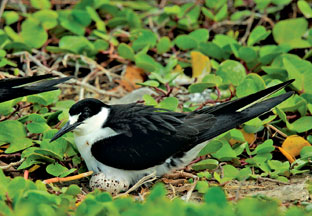 Currently 441 species of birds are recorded in the country of which
236 are breeding residents with the rest being purely migrants. A number
of further new migrant species is under evaluation by the Ceylon Bird
Club Rarities and Records Committee (CBCRRC), and those ratified will be
added to the country list of birds. With this finding the number of
breeding residents in the country will go up to 237. Currently 441 species of birds are recorded in the country of which
236 are breeding residents with the rest being purely migrants. A number
of further new migrant species is under evaluation by the Ceylon Bird
Club Rarities and Records Committee (CBCRRC), and those ratified will be
added to the country list of birds. With this finding the number of
breeding residents in the country will go up to 237.
Many other species of rarely seen sea birds such as Saunders Tern
Sterna saundersi, Bridled Terns Sterna anaethetus, and Roseate Terns
Sterna dougallii as well as species such as the Large-crested Terns
Thalasseus bergii velox use these uninhabited islands as communal
breeding colonies due to the lack of any ground living predators such as
Reptiles, Rodents or domestic animals such as Cats & Dogs. As there are
only a few such islands which are uninhabited the pressure for these
birds to find a suitable site to nest even in these islands is very high
with many species breeding very close to each other.
The two researchers said that it was of paramount importance to
conserve these islands and to ensure that they are left undisturbed as
these birds may well have used these islands for centuries as their
breeding grounds. " We wish to acknowledge the support given by the Sri
Lanka Navy during our study and are sincerely grateful to them for
taking measures to protect these last remaining breeding grounds of
thousands of sea birds", they said.
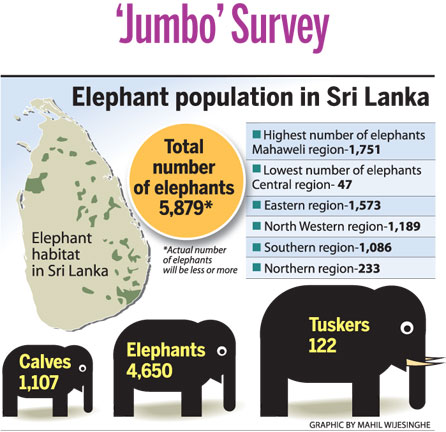
"I love elephants and will not permit the capture of tuskers from the
wild. This is to know the number of elephants in the country and also to
implement a proper management plan to reduce the human-elephant
conflict. I will not breach the law regarding this issue", releasing the
first-ever National Survey on elephants Minister of Agrarian Services
and Wildlife S.M. Chandrasena said.
Eco news
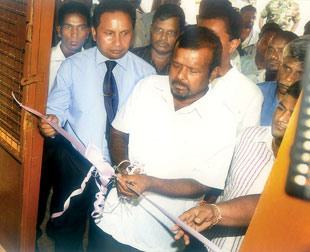
Katagamuwe Zone
The Katagamuwe Zone in the Yala National Park was opened early this
week to facilitate visitors from Kataragama to Yala. The travel distance
has been reduced by 19 kilo metres to Yala. The Katagamuwe entry point
was closed for visitors for nearly three decades due to terrorist
activities.
The DWLC has taken steps to renovate bungalows and improve other
facilities for visitors at the Yala National park before end 2012. Here
Minister of Agrarian Services and Wildlife S.M. Chandrasena, who was the
chief guest, opens the entry point. DWLC Director General H. D.
Ratnayake is also in the picture.
Wildlife lecture
Mahendra Siriwardhana, eminent conservation biologist and researcher
in wildlife ecology and systematics, will deliver a lecture on
"Exploring the faunal species diversity in Sri Lanka"
The lecture, under the auspices of the Wildlife and Nature Protection
Society will be held on Thursday September 15 at 6.00 p.m. The venue
will be Institute of Engineers Sri Lanka (Wimalasurendra Auditorium)
120/15, Vidya Mawatha, Off Wijerama Mawatha (BMICH end), Colombo 07. It
is open to the public.
Crocodile conservation
The Department of Wildlife conservation is to open the first
crocodile park mainly for crocodile conservation at the Muthurajawela
wildlife sanctuary. The park will shelter the crocodile species -
Crocadylus porosus and Crocadylus palustris- recorded in Sri Lanka.
The main objective of the project is to make the site a transit home
for unhealthy and disabled crocodiles found in various places, to make
it a home for crocodiles found in conflict with humans, a breeding
centre for crocodiles to establish a conservation centre and research
centre are also in the pipeline
Picture of the Day
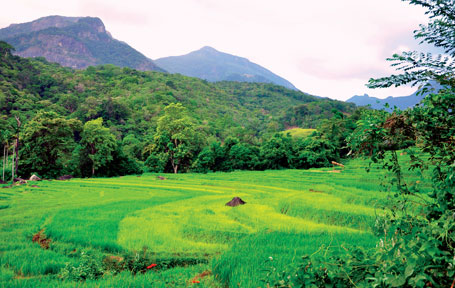
Ancient villagers in Sri Lanka had an eco-friendly living, before
concrete buildings and hi-technology reached them. They preserved the
charming beauty of their villages. With modernisation such villages are
fast disappearing but Mee Mure, an ancient village hidden in the
Knuckles Range still boasts about its breathtaking beauty.
Mee Mure nestles in the borders of Kandy and Matale Districts and
shelters over 103 families who depend on agriculture. Though the
villagers have embraced modern facilities, they harmoniously co-exist
with nature.
|

"Look at my work, how
beautiful and perfect is
everything that I created.
I created it for you.
Be careful not to ruin and
destroy My world. If you
ruin it, there is nobody to
restore it after you…"
(Ecclesiastes Rabba, written
between the sixth and eighth centuries) |
|

